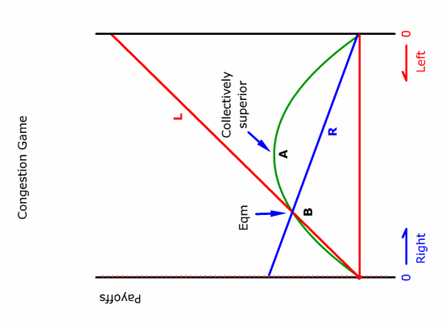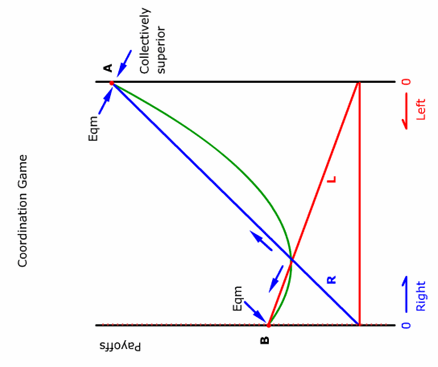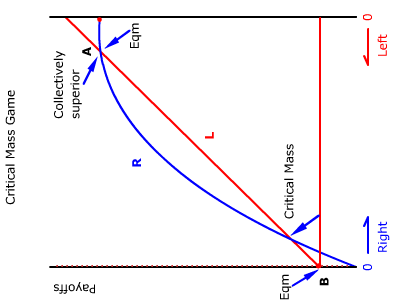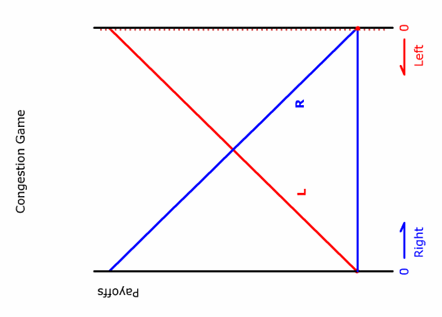Concurrent competing standards
- lower the average total cost of adopters due to scale economy.
- are wasteful because one standard is just as good as the other.
- encourage consumer purchase of durable goods before the dust is settled.
- offer more choices before prematurely committing to an inferior technology.
A dominant strategy
- always guarantees a collectively superior solution.
- always guarantees a collectively inferior solution.
- always exists in strategic games.
- has better payoffs regardless of what the strategy the other players might choose.
Tipping is
- An ever-escalating arms race that does not have an equilibrium solution.
- A fixed-level Nash equilibrium.
- A collectively superior solution.
- Both B and C.
Which of the following describes the outcome of an invisible-hand game?
- Individually smart, collectively dumb.
- Individually smart, collectively smart.
- Individually dumb, collectively smart.
- Individually dumb, collectively dumb.

When the payoff curves in a congestion game are not symmetrical, uncoordinated
individual activities often lead to a solution which
- is collectively optimal.
- may not be collectively optimal.
- may not be a Nash equilibrium.
- Both A and B.
Network goods tend to grow explosively
- After a critical mass is reached.
- Right from the beginning.
- Because they generate positive externality among themselves after a critical threshold.
- All of the above.
- Both A and C.
Which of the following is correct in a prisoner's dilemma game?
- The higher the cost of detecting defectors, the smaller will be the percentage of defectors.
- The percentage of defectors is not affected by the cost of detecting defectors.
- The higher the cost of detecting defectors, the larger will be the percentage of defectors.
- The lower the cost of detecting defectors, the larger will be the percentage of defectors.
Economic growth is an invisible-hand game within a larger context of
- a tragedy of the commons.
- a gender-preference game.
- a coordination game.
- a critical-mass game.

In a coordination game with multiple stable equilibriums,
- the chosen solution is always collectively superior to the unchosen one.
- the chosen solution is a Nash equilibrium.
- it is easy to migrate from one equilibrium to another.
- Both A and B.
Ignoring software piracy for home use serves to
- lock in these users as lobbyists for the same software to their future employers.
- increase the cost of enforcing legal licensing.
- increase the support cost of the software company.
- delay the building up of the user network to the threshold size for explosive growth.

Adoption of networked goods often stops short of 100% because
- non-adopters can free ride on adopters.
- the payoff for non-adopters is lower than the adopters.
- networked goods are strictly public goods.
- networked goods are strictly private goods.

In a coordination game, the payoff of those who pursue L _____ as _____ people pursue R.
- decreases; more
- increases; more
- decreases; fewer
- increases; fewer
- Both A and D.

In this diagram of payoffs where blue represents boy
preference and red represents girl preference, which of the following is
true?
- At B, some parents would opt for girls because there is a scarcity of girls.
- If the temporary situation happens to be at A which is collectively superior, there is a tendency to stay there.
- The equilibrium solution at B is not stable because A is collectively superior.
- Those who prefer sons always have higher payoffs than those who prefer girls even though son-preferred parents can have higher average payoffs by having fewer sons.

Fill in the blanks?
_______ a critical mass is reached, the payoff for joining is ______ than the payoff for not joining.
- Before; higher
- After; lower
- After; higher
- Both A and C.
The obesity game is an illustration that many seemingly benign invisible-hand games are
- individually and collectively smart.
- individually smart, but collectively dumb.
- a coordination game.
- a critical-mass game.
Which of the following products have major network externality effects?
- coffee
- sun glasses
- Both C and D.

In this diagram of payoffs where blue represents boy
preference and red represents girl preference, which of the following is
true?
- If the temporary situation happens to be at A which is collectively superior, there is a tendency to stay there.
- The equilibrium solution at B is not stable because A is collectively superior.
- At B, some parents would opt for girls because there is a scarcity of girls.
- B is a stable solution because son preference is a dominant strategy.
In order to prevent defection from an unstable but collectively superior solution in a prisoner's dilemma game,
- the potential gain of defection could be taxed away.
- the potential loss of not defecting could be offset.
- people should be allowed to do what they want.
- people should be told they are in a prisoner's dilemma.
- Both A and B.
Which of the following describes the outcome of a prisoner's dilemma game?
- Individually smart, collectively dumb.
- Individually smart, collectively smart.
- Individually dumb, collectively smart.
- Individually dumb, collectively dumb.

In a congestion game, the payoff of those who pursue L _____ as _____ people pursue R.
- decreases; more
- increases; more
- decreases; fewer
- increases; fewer
- Both B and C.